Figuring out how many solar panels a power station can handle is tough. But you’re in the right spot for help. This is an interactive guide will help you figure out how many panels to use and will provide an image to help visualize the solar panel connections.
After filling in basic details about your devices, this wizard automatically calculates how many solar panels your power station can handle. It breaks it down by series and parallel connections, so you’ll know exactly how to line things up. And it shows you an image of how it should look!
Let’s get started so you can connect your solar panels right away.
We carefully select the products and services we link to. If you buy through our links, we may earn a commission. There’s no extra cost to you and it helps us provide this information.
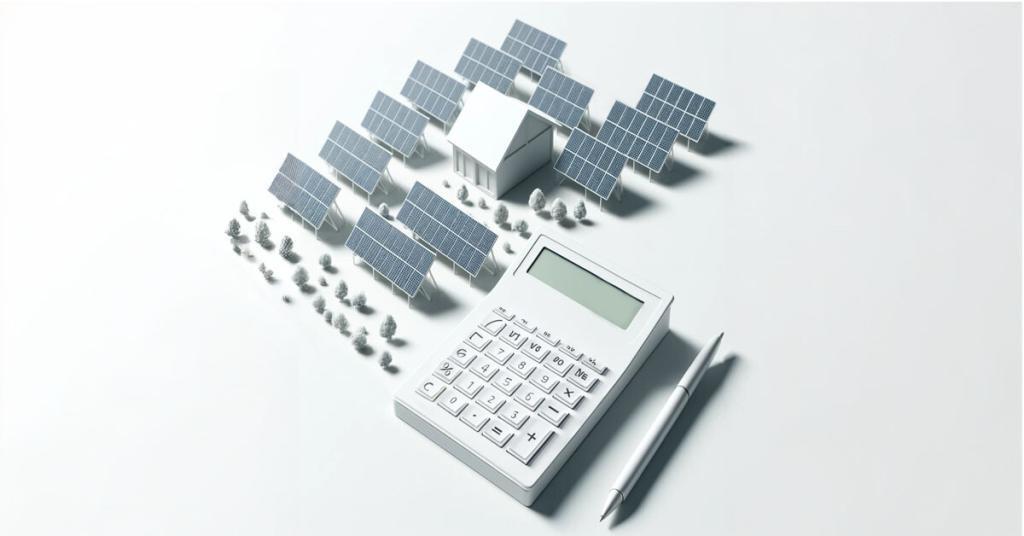
How Many Solar Panels Can You Use?
Before you can find out how many solar panels your power station can use, find the specs. These are in the user manual for your power station and solar panels. You may also find them on the sales listing page.
Caution: This guide takes many factors into account to calculate the right amount of panels. But every system is unique and should be carefully reviewed before installation. This information is for educational purposes and does not constitute professional advice. Use at your own risk.
- How Many Solar Panels Can You Use?
- Power Station Wizard Details
- Understanding Solar Panels and Power Stations
- Temperature Adjustment for Voltage
- Series and Parallel Connections
- Overpaneling: What It Is and Why It Matters
- Practical Considerations for Buying Solar Panels
- Wrap Up: How Many Panels Can Your Solar Generator Use?
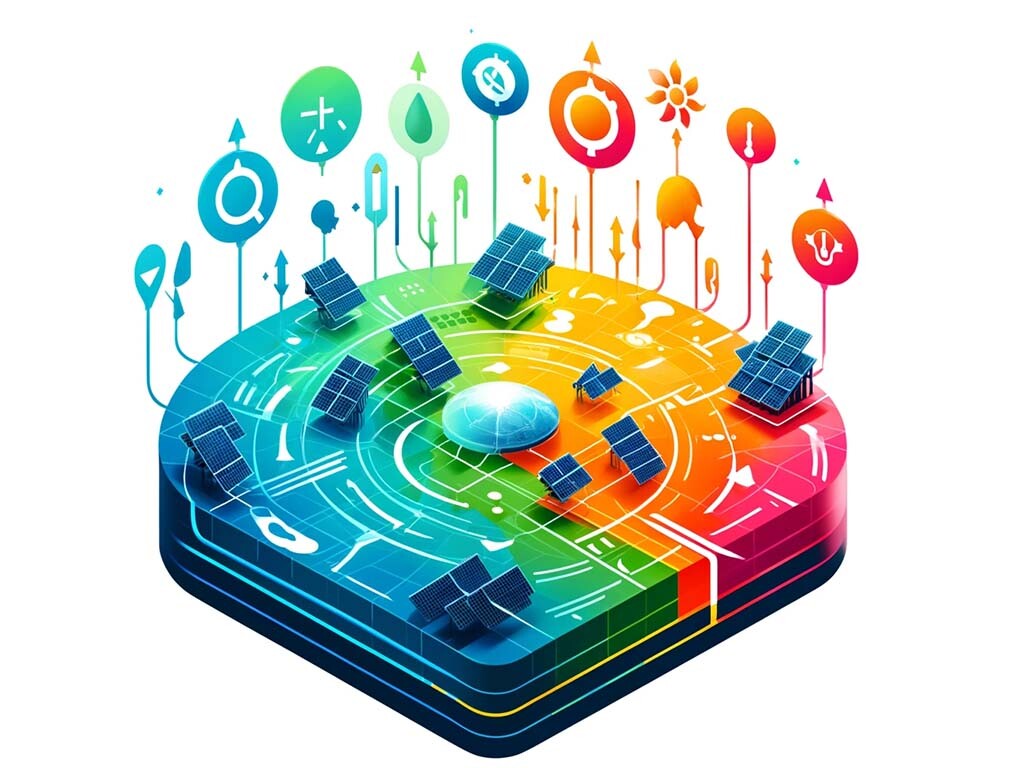
Power Station Wizard Details
Where can I find the specifications for my power station and solar panels?
The user manuals of your power station and solar panel will have these details. You can also look at online listings to find a product datasheet with this information.
The power station information will be under solar input (aka DC input or PV input). It may list the voltage in a range.
What does the temperature adjustment do?
The temperature adjustment accounts for changes in voltage based on temperature. Colder temperatures can increase the voltage output of your solar panels.
If you don’t account for this, the voltage may be too high. This is dangerous and can permanently damage your devices. This calculator uses NEC Table 690.7(A) as the adjustment factors.
What is the difference between series and parallel connections?
In a series connection, the voltage of each panel adds up, while the current remains the same. Series connections are when you attach the negative terminal of one panel to the positive terminal of another panel. In a parallel connection, the current adds up, while the voltage remains the same. Parallel connections are when you attach multiple negative terminals in one connection using an adapter, then do the same for the positive side. Parallel connections often connect strings of series-connected panels together.
Understanding these connections is crucial. It changes the voltage and current (amps). Check out our article on How to Connect Solar Panels: Series vs. Parallel for more information.
What is overpaneling and is it safe?
Overpaneling is when the total wattage of the solar panels exceeds the maximum input wattage of the power station. It is a well-known strategy to maximize your solar power generation, particularly during low-light conditions (cloudy weather, early mornings, and late afternoons). This is done by going over the amperage limits. You should NEVER exceed the input’s maximum voltage.
The only catch is that during peak conditions, the panels will generate more power than your system can absorb. Some people see it as an important way to maximize solar charging. Others see it as a waste of money. And if you go too far over, there is some risk in generating too much heat.
How much overpaneling to go with is a judgement call. Some experts avoid overpaneling entirely. Others will go with a small 10% overage. Some will go up to about 1.5x (50% more) the input’s maximum amperage. A few will say there’s no limit at all, relying on the input to limit the current on its own.
We automatically include a small 10% above the maximum amps in this calculator. If you feel confident going higher, simply enter the maximum amount of amps in the “POWER STATION Max Amperage (A):” field.
Is there a minimum number of panels?
Every power station has a minimum voltage. If your solar panels do not reach that minimum amount, the power station won’t absorb any energy from them. Using fewer panels than this minimum might result in no charging, especially in low-light conditions.
Is this information accurate?
This calculator provides a starting point for designing your system. Always verify the calculations and consult with a professional to ensure accuracy. The calculator does not replace professional advice or detailed system planning by a qualified solar installer.

Understanding Solar Panels and Power Stations
Now that you have this basic information, let’s take a closer look into deciding the right amount of solar panels for your power station.
Choosing the Right Number
When selecting solar panels for your solar generator, you’re deciding on the amount of power that the solar panels will be able to generate. It’s really about how fast they will charge the power station. Do you want just a little energy to trickle in over a long time? Or do you need the most energy possible, as quickly as possible?
Many people want to get the most amount possible. And to do that, you can use this calculator to match the solar input to the most solar panels it can use.
All of the specifications are important, but the most critical is the maximum voltage of the input and the Voc of the solar panels. You absolutely cannot exceed the power station’s voltage limits. Series connections are what can cause a lot of trouble with voltage. Ambient air temperatures also cause voltage to increase.
If you want to maximize your solar power generation, you can use more watts of solar panels than the solar input can handle (overpaneling). People in cloudy areas or that really want to maximize their solar power generation will do this, knowing that it may create more energy than the system can absorb. The way this is done is by going over the input amps – NEVER go over the input max voltage.
Are you unsure of how much power you need to generate? Head over to this article to calculate how many panels you need to generate the right amount of electricity. Once you know that, you can come back here to figure out if its safe for your power station.
Watts, Amps, and Volts
There’s a very simple relationship between these three numbers:
For example, if your solar panels are 200W, they could be 20V and 10A. Other 200W panels could be 18V and 11.1A. Not all solar panels are the same, even if they have the same wattage.
These same differences can happen on the power station. You can have two power stations that both can use up to 2,000W of solar power. But they can have VERY different volt/amp specs. For example, one could use 200V and 10A, but the other could be 100V and 20A. You’ll need to adjust the solar panel series/parallel connections accordingly.
Batteries are rated in watt-hours. The relationship between watts and watt-hours is simple: running 1W for 1 hour = 1Wh. You can check out our article on off-grid batteries to learn more about battery chemistry and watt-hours.

Understanding Power Station Specifications
The specifications that matter here are for the solar input. Power stations have other wattage specs for the power inverter (AC W) and the battery size (Wh). You can ignore those. Just stick with these specs for the solar input:
1. Solar Input Wattage: This is the amount of power that the power station can accept through the solar input. The more solar panels attached, the higher the wattage and the faster the recharge rate.
2. Solar Input Voltage Range: The voltage range (minimum and maximum) indicates the acceptable input voltage for the power station. This range is critical for ensuring that the power station can handle the voltage generated by the solar panels. You cannot exceed it. And if you don’t get to the minimum voltage, it won’t take in the energy to charge the battery.
3. Solar Input Max Amperage: This is the maximum current the power station can accept. It helps determine how many panels you can connect in parallel without exceeding the current limit. It is acceptable to go over the amperage. This helps with low-light conditions because the panels don’t go over the limits in low light. But if the panels actually generate more than the allowable amps (peak sunlight), the power station won’t use the extra energy.
You can find a lot of the specifications and links to user manuals in our posts covering the full lineup of power stations:
Some power stations and solar generators, such as the EcoFlow Delta Pro Ultra, have two solar inputs. Run this calculator separately for each input. You’ll create two independent systems with two different connections to the power station.
Understanding Solar Panel Specifications
On the other side of the equation are the specs from the solar panels. The items you need to know for your solar panels are:
- Panel Wattage: The power output of a single solar panel. It is essential for calculating the total power your solar array can generate. The wattage always adds up, no matter how panels are connected.
- Operating Voltage: The voltage at which the panel operates under standard conditions. This is important for the minimum voltage calculation to make sure the panels usually create enough energy for the power station to notice and absorb the charge.
- Open Circuit Voltage (Voc): The maximum voltage the panel can produce. This value is crucial for ensuring the panels don’t exceed the power station’s voltage range. It increases when temperatures go down. And the Voc of each panel adds together when they’re connected in series.
- Short Circuit Current (ISC): The current that flows when the panel’s output is shorted. It helps determine the current contribution of each panel in parallel connections. You can use more current than your power station absorbs, it just won’t go in to the battery.
Some solar panels line up with certain systems better than others. You want to find a set of panels with voltage and amperage that lines up well with the power station’s input. For example, if you have a power station that can accept 30V, but a solar panel with a Voc of 20V, that’s a bad match. There’s 10V open that you’ll never be able to use. You can’t use two 20V panels because that exceeds the 30V input.
Ideally, you want to use panels that fit very well with the power station’s voltage and amperage limits.
You also need to use caution when mixing different solar panels. The connections will limit the voltage and amps according to the lowest single panel in the string. If you don’t account for this and use a 100W panel with a string of 400W panels, you might limit them all to the 100W output.
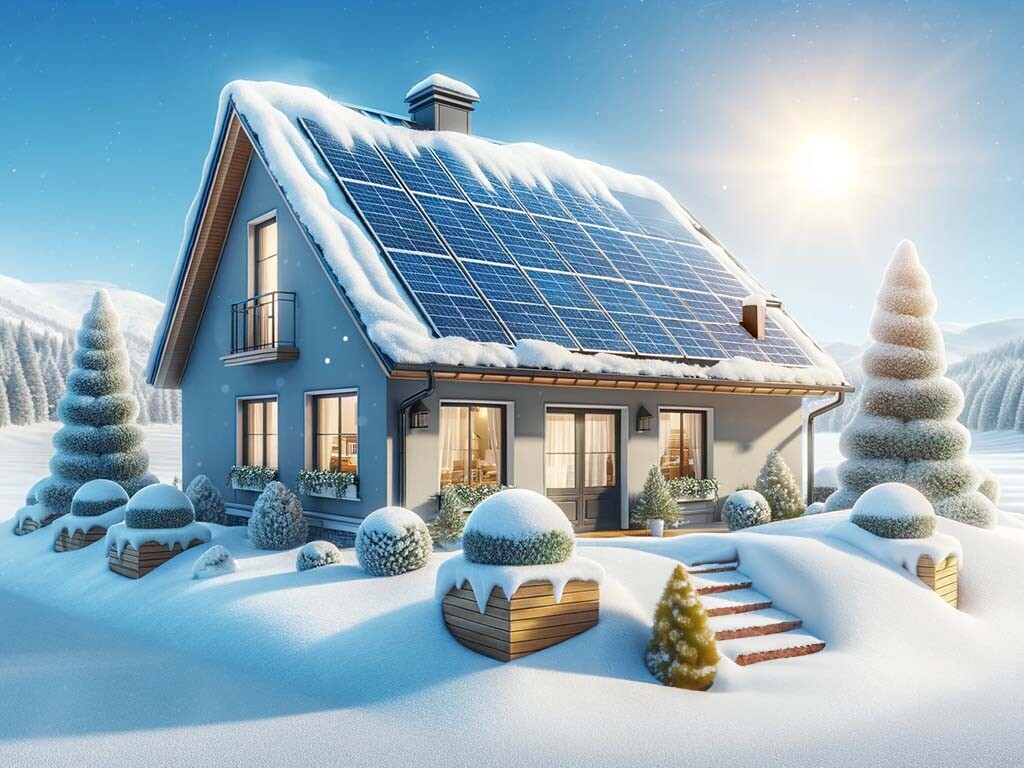
Temperature Adjustment for Voltage
The voltage output of any solar panel varies with temperature. Colder temperatures increase the voltage output, while hotter temperatures decrease it.
The NEC/ICC Table 690.7(A) provides correction factors for adjusting the voltage based on ambient temperature. This adjustment ensures your system operates safely under different environmental conditions.
| Table 690.7(A) | ||
| Ambient Temperature (°F) | Ambient Temperature (°C) | Adjustment Factor |
| 76 to 68 | 24 to 20 | 1.02 |
| 67 to 59 | 19 to 15 | 1.04 |
| 58 to 50 | 14 to 10 | 1.06 |
| 49 to 41 | 9 to 5 | 1.08 |
| 40 to 32 | 4 to 0 | 1.10 |
| 31 to 23 | -1 to -5 | 1.12 |
| 22 to 14 | -6 to -10 | 1.14 |
| 13 to 5 | -11 to -15 | 1.16 |
| 4 to -4 | -16 to -20 | 1.18 |
| -5 to -13 | -21 to -25 | 1.20 |
| -14 to -22 | -26 to -30 | 1.21 |
| -23 to -31 | -31 to -35 | 1.23 |
| -32 to -40 | -36 to -40 | 1.25 |
This makes a big difference in how many panels you can connect safely to a power station. If you only rely on the ratings without looking at temperatures, you could go over the input voltage. This will damage your system and is a dangerous situation.
You don’t want to deal with a system emergency and potentially fire on a deep freeze day with sunshine.
Make sure to account for the absolute lowest temperatures these panels will see. If you encounter colder temperatures than planned, you should unplug the panels from the system (not just turn it off).

Series and Parallel Connections
There are two ways to connect solar panels together:
- Series Connection: Connecting solar panels in series adds up their voltages while keeping the current the same. It helps match the combined voltage to the power station’s input range. Make a series connection by attaching the positive terminal from one panel to the negative terminal of another. Panels string together in a series.
- Parallel Connection: Connecting solar panels in parallel adds up their currents while keeping the voltage the same. It helps match the combined current to the power station’s input capacity. Parallel connections require special adapters that bring all positive connections to one point, such as a 3-to-1 Y cable.
You can refer to systems in a shortcode to show the series/parallel connections, such as:
- 4S2P is 4 series and 2 parallel.
- This is an 8 panel array. It has 2 different strings of 4 panels each.
- Series connections: 4 panels are connected to one another from the positive terminal of one to the negative terminal of another. You’re left with one open connection on each end, one positive and one negative. Then a second set of 4 panels is connect in the same way.
- Parallel connections: You use a 2-to-1 adapter to connect the two positive terminals and two negative terminals.
For more details, head over to our posts on How to Connect Solar Panels. We also show the best tools for the job.
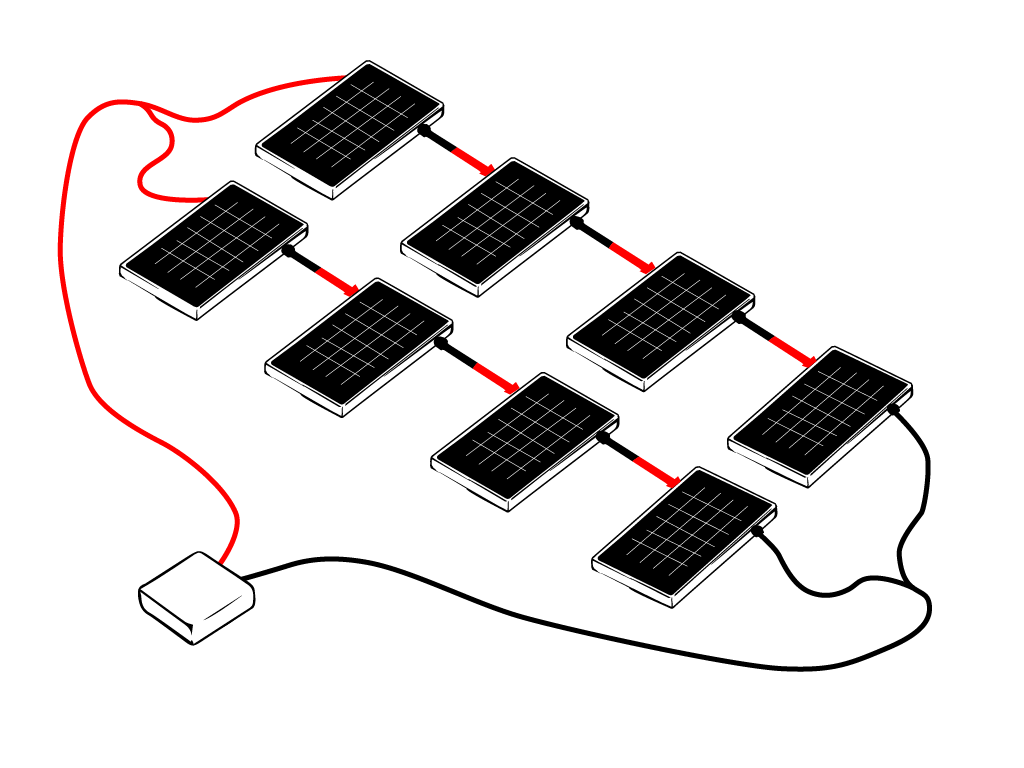
Overpaneling: What It Is and Why It Matters
Overpaneling occurs when the total wattage of the solar panels exceeds the power station’s maximum input wattage. Properly managed overpaneling can enhance system performance during cloudy weather or early mornings and late afternoons.
But it also means you’re buying more panels that your system can absorb during peak sunlight hours. It’s a tradeoff that costs a little extra money to create more power in low-light conditions, knowing you won’t get the full benefits during peak hours.
This is most often used in areas with many cloudy days. It can also be useful at high latitudes when the sun is low on the horizon during winter.
Overpaneling is done by going over the amperage limits of the power station. Although you can’t exceed the input voltage, it is acceptable to go over the amperage. This is like hooking up a 30-amp plug to a 50-amp outlet (with the right adapter). Your 30-amp connector will only pull off the energy it needs. Your power station will do the same thing.
The exact amount of allowable overpaneling through exceeding amperage is somewhat of a judgement call. Expert opinions can range from zero overpaneling (always stay within the limits) up to an infinite amount of overpaneling (always relying on the power station to limit the current it pulls). Somewhere around 1.5x or 150% of the maximum amps is a compromise that some experts agree with. One top brand (EcoFlow) says in certain user manuals, “Ensure the total solar current (Imp) is CLOSE TO the maximum input current (Imax) of the PV input port.”
We limit the automatic calculator to just 10% as a way to help people identify a number of panels that’s a good match for the input without seriously overpaneling. If you want to see what more overpaneling looks like, adjust the amperage input field to your desired maximum amperage. We cannot guarantee the safety of any system, especially one that exceeds the rated limits of the power station.
Practical Considerations for Buying Solar Panels
There are a few other things to keep in mind when figuring out how many solar panels to get for your solar generator:
- Check Compatibility: Ensure the solar panels’ voltage and current specifications match your power station’s requirements. It’s also best is the solar panel specs evenly divide into the power stations’ specs. E.g., solar panels with a temp-adjusted Voc of 20V are great for a 40V input, but they’re bad for a 30V input.
- Calculate the Number of Panels: Use a calculator (like the one above) to determine the optimal number of panels in series and parallel. Make sure to verify the voltage and series connections to avoid serious problems.
- Consider Environmental Factors: Take into account the ambient temperature and adjust the panel Voc accordingly to ensure safe and efficient operation. NEC Table 690.7(A) is a good resource.
- Plan for Expansion: If you anticipate expanding your system in the future, ensure that your initial setup allows for easy addition of more panels. You can add more panels in series without much of a hassle. Changing parallel connections means you’ll have to buy new adapters and get rid of the old ones.
- Quality and Warranty: Choose high-quality solar panels and power stations with good warranties to ensure long-term reliability and performance. Treat them with care to ensure longevity. And register your warranty immediately upon purchase. This can sometimes extend your warranty, but it also makes any future claims much easier.
- Verify Connections: Large power stations typically use the same MC4 connectors as solar panels. But many smaller power stations and solar generators use specific connectors, such as an XT-60, to attach solar panels. In some cases (like EcoFlow), it’s important to use the brand’s cable as it ensures proper communication and use of the panels.
- Mixing Solar Panels: You can almost-always use any solar panel with any power station. But if you use two different solar panels, you can have problems. Series connections will use the lowest amps in the whole string. Parallel connections will use the lowest voltage in the whole string. This can severely limit production. Use caution when mixing solar panels with different
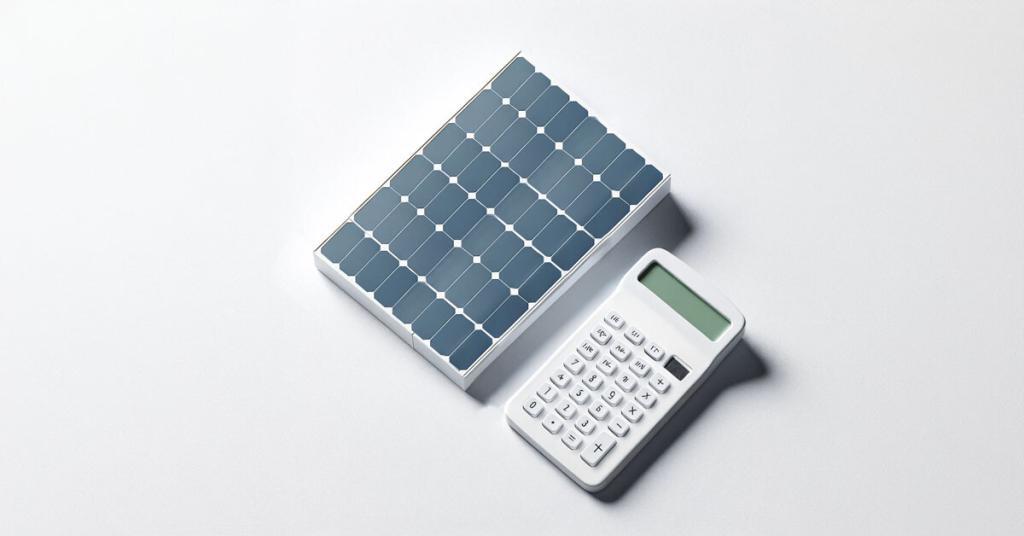
Wrap Up: How Many Panels Can Your Solar Generator Use?
Selecting the right number of solar panels for your power station or solar generator is crucial. It involves understanding the specifications, adjusting for environmental factors, and considering connections. Using this detailed calculator and comprehensive guide can help you make informed decisions, ensuring your solar power system operates efficiently and safely. Always consult with a professional for detailed system planning and installation.
Sometimes solar power doesn’t do what we need. The EcoFlow Dual Fuel Generator is a great way to produce power when that happens. It’s app-controlled with electric start, making it one of the most convenient pure sine wave fuel generators around.







